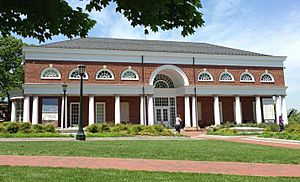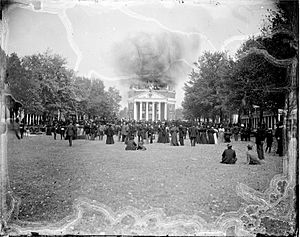Albert and Shirley Small Special Collections Library facts for kids
The Albert and Shirley Small Special Collections Library at the University of Virginia is a special library. It holds many rare and important items. These include old books, letters, and documents. The library focuses on American history and literature. It also covers the history of Virginia and the University of Virginia.
The library is named after Albert and Shirley Small. They gave a lot of money to help build the library's current home. Albert Small, who went to the University of Virginia, also gave his amazing collection of historical papers. This collection includes a very rare early printing of the Declaration of Independence. This special document is called a Dunlap broadside. With this gift, the University of Virginia became the only place in America with two copies of this first printing of our nation's founding document. The collection also has the only letter written on July 4, 1776, by a signer of the Declaration, Caesar Rodney.
The Albert H. Small Declaration of Independence Collection has a cool digital display. Visitors can explore these old documents on a screen. This lets everyone, including kids, see and interact with the copies. It protects the real, old documents from getting damaged.
The library has many different types of collections. Some of the most famous include:
- The Tracy W. McGregor Library of American History
- The Clifton Waller Barrett Library of American Literature
- Collections about famous author William Faulkner
- Collections about Jorge Luis Borges
- The Sadleir-Black Collection of Gothic Fiction (spooky stories!)
- Many books, letters, and photos about Virginia's history
- Original documents about Thomas Jefferson's life and work
Other important collections include papers from presidents James Madison and James Monroe. There are also papers from Dolly Madison. The library has items about how books are made (typography). It also has old store catalogs (trade literature). You can find stories from formerly enslaved people (slave narratives). There are also documents about equestrianism (horse riding) and other traditional sports. The library holds records of the Southern Civil Rights Movement. It also has papers from important Virginia politicians. Plus, it has one of the world's largest collections of miniature books.
Contents
History of the Library
Thomas Jefferson designed the University of Virginia. He put a library at its center, not a chapel. This was different from other American colleges at the time. Jefferson also made the first list of books for the library. He asked for book donations to fill the new library, which was inside The Rotunda.
James Madison was the university's second leader after Jefferson. In 1836, he started the first fund to buy new books. This was done through his will. In 1895, The Rotunda caught fire. Most of the library's books were destroyed. Only about 20% of the original books survived. These are the oldest books still held by the Small Special Collections Library today. Librarians have worked for many years to replace the lost books. The university's old records and the papers of Richard Henry Lee also survived the fire. These papers were given to the university before 1832.
In the early 1900s, many rare items were added to the library. These included both books and old letters. The library also bought important collections, like the John Henry Ingram collection of Edgar Allan Poe's works. In 1930, a special "Virginia Collection" was started. The first person to organize old records (archivist) was hired.
A new main library, Alderman Library, was built in 1938. The rare books and manuscripts were then organized into a special division. Over time, these parts separated. By 1962, there were two divisions: Rare Books and Manuscripts/University Archives. These two groups joined back together in 1987. They formed the Special Collections Department. The current building for the library opened in 2004.
Amazing Collections
Important Early Collections
In 1938, the library received a huge gift. This was the collection of Tracy W. McGregor, a book collector. His collection included rare books, maps, and old letters. These items covered American history, British literature, and works by Cotton Mather. This gift immediately made the University of Virginia a top place to study American history and culture.
In 1960, another major collection arrived. Clifton Waller Barrett placed his large collection of American writers' books and papers at the library. This made the library a key place for studying American Literature. The library has continued to collect items in the same way since then. Barrett's full donation was completed in the early 1990s.
The Barrett collection has first editions of almost every major American literature work up to 1950. It also has many lesser-known works. Some special items include:
- Over a hundred letters from early American novelist Charles Brockden Brown
- Handwritten copies of works by Washington Irving and James Fenimore Cooper
- Many handwritten pages for the second edition of Walt Whitman's Leaves of Grass
- A large collection of papers from Louisa May Alcott and her family
- Important papers and letters from Mark Twain
- The papers of Stephen Crane, including a handwritten copy of The Red Badge of Courage
- Over 650 letters from Henry James
- Many papers and letters from Lafcadio Hearn, Robert Frost (including a new poem), and Ernest Hemingway
- Papers from novelists John Dos Passos and Ellen Glasgow
- Papers from poets Vachel Lindsay and Sara Teasdale
Thomas Jefferson's Legacy
The university has many original documents about Thomas Jefferson and his family. These include hundreds of letters he wrote and received. You can also see his architectural drawings and family papers. The library has many books from Jefferson's own collection. There is also a large collection of books about Jefferson. Special items include one of his polygraphs (a machine that made copies of letters). You can also see the telescope he used to watch the university being built from his home, Monticello.
University Records and Faculty Papers
The library keeps records of the university's history from its very beginning. This includes the original minute book of the Board of Visitors. Much of it was written by Thomas Jefferson himself. There is also the first book that listed every student who joined the university early on. This includes famous students like Edgar Allan Poe. Old financial records show how the university buildings were constructed. They also show how enslaved laborers were rented to build and maintain the campus. These records also show how the school's courses developed.
Later documents from the late 1800s and 1900s show how the university grew. They cover student groups, campus expansion, and important discussions. These discussions included the university's past policies about not admitting women and Black students.
Papers from many important university professors are also kept here. These include civil rights activist Julian Bond. They also include physicist Jesse Beams, poet Charles Wright, and novelists Ann Beattie and John Casey.
William Faulkner's Works
The University of Virginia has the largest collection of printed and handwritten materials about William Faulkner. He was a famous writer. He visited the university as a guest professor in the 1930s and late 1950s. Faulkner started the William Faulkner Foundation. This helped make sure his papers would stay at the university after he passed away in 1962.
This collection has most of the handwritten and typed copies of Faulkner's novels and short stories. It also includes many letters and other related items. In 1960, a scholar named Linton Massey donated his huge collection of Faulkner's books and other works. Faulkner's daughter, Jill, also gave many more handwritten papers and over 300 books from her father's library. Other collections, like the papers of Faulkner's biographer Joseph Blotner, have also been added. This collection is the basis for a major online archive of Faulkner audio recordings.
Virginia's History
The collections are a very important source for learning about Virginia's history. They are especially strong in records from Charlottesville and Central Virginia. Collections from many important Virginia families, farms (plantations), and businesses are here. These are key historical materials from Virginia's earliest days to now.
Old farm and family papers have rare information about enslaved people. This includes a special collection of letters written by formerly enslaved Virginians who moved to Liberia. The collections also show how people in the region discussed race. They include records from people who supported eugenics (a harmful idea about human breeding). They also include records from civil rights activists. The records of the Charlottesville School Board are also important. They show the time of desegregation (ending racial separation in schools) and massive resistance (efforts to stop it). Papers from Charlottesville and Albemarle County politicians are also very detailed.
Political Cartoons and Caricature
The library has many political or editorial cartoons. These include the papers of Richmond cartoonist Ed Seibel. They also have works by UVA graduate Bob Gorrell and Art Wood. The Gerald Meeks Collection has many examples of American cartoon artists. Among its treasures are many original drawings by Oscar Cesare. The papers of Edward Stettinius Jr. include many original editorial cartoons about the start of the United Nations. A complete set of caricatures from Vanity Fair (UK magazine) is also in the library. In 2018, the library got the papers and original art of editorial cartoonist and artist Pat Oliphant.
Gordon Collection
The Gordon Collection (also called the Douglas H. Gordon Collection) has about 1200 French books. These books date from the 1500s to the 1800s. Over 600 of them were printed before 1600. Many still have their original covers.
Learning and Sharing
Many different people visit the Special Collections library. Its items have been shown in important publications all over the world. There are also big online projects that use these collections. These include:
- The Walt Whitman Archive
- The Edgar Allan Poe Society's website
- The Rossetti Archive
- Mark Twain in his Times
- Uncle Tom's Cabin & American Culture
The library has also created several large digital collections itself. One is the Jackson Davis Collection. This is a great resource for studying African American educational history. Another is the photo archive of Rufus Holsinger's studio. He took pictures of life in Charlottesville, Virginia. This was the first University of Virginia collection to join the Digital Public Library of America project. It was also one of the first collections in the DPLA.
The library's collections are very important for many courses taught at the Rare Book School. This school helps hundreds of scholars, librarians, and book dealers each summer. The library has many old book covers, early printed works, and a working Hinman Collator (a machine to compare books).
In 2012, the Special Collections played a big role in documenting a major event. This was when the university's president, Teresa Sullivan, was removed and then brought back. The library collected physical documents about how the public and news reacted. It also made news for collecting digital materials. They even accepted materials collected by people from the public for the library.
Images for kids




